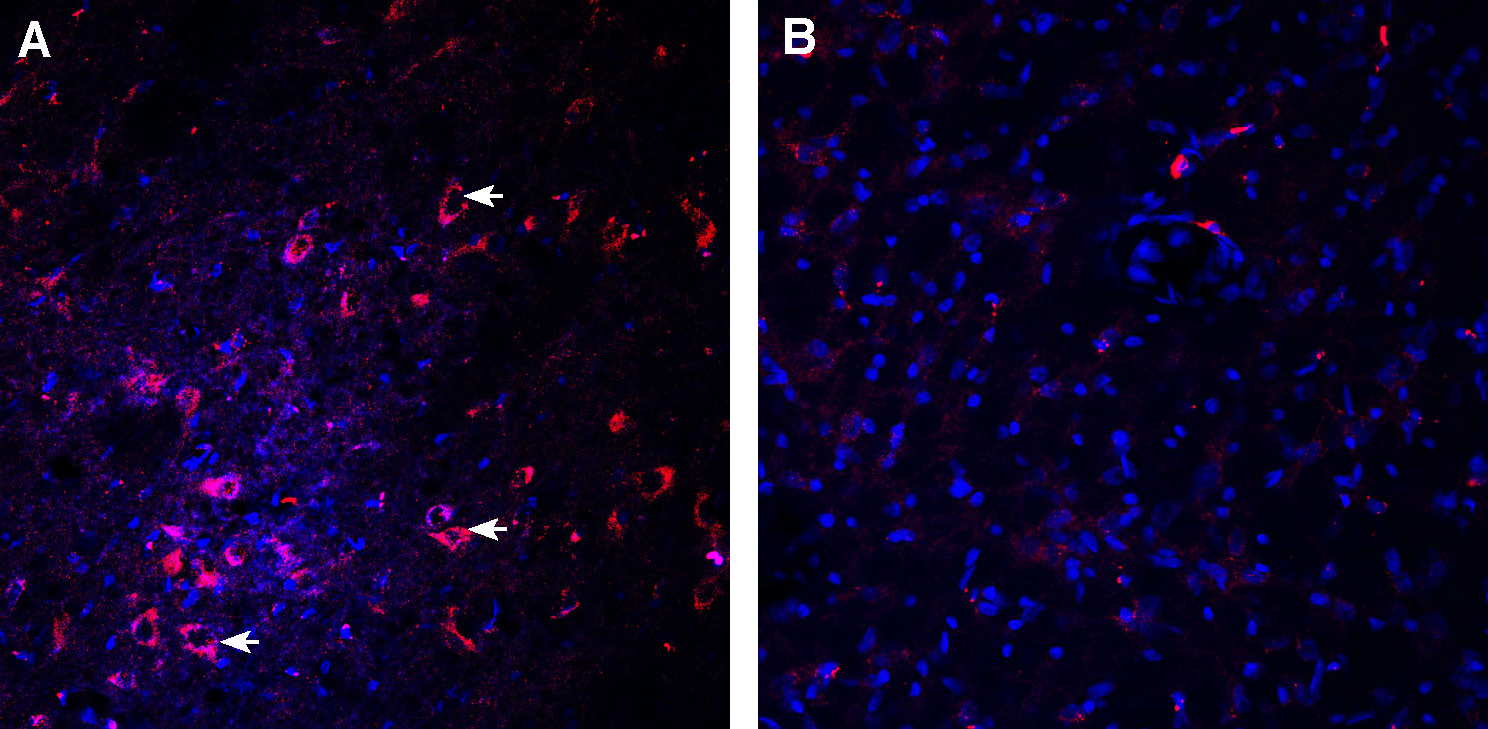Overview
- Peptide (C)DAHASNSSDGLGLND, corresponding to amino acids residues 191-205 of rat SLC6A3 (Accession P23977). Extracellular, 2nd loop.

Dopamine Transporter/DAT (extracellular) Blocking Peptide (#BLP-MT003)
 Western blot analysis of rat brain membranes:1. Guinea Pig Anti-Dopamine Transporter (DAT) (extracellular) Antibody (#AMT-003-GP), (1:200).
Western blot analysis of rat brain membranes:1. Guinea Pig Anti-Dopamine Transporter (DAT) (extracellular) Antibody (#AMT-003-GP), (1:200).
2. Guinea Pig Anti-Dopamine Transporter (DAT) (extracellular) Antibody, preincubated with Dopamine Transporter (DAT) (extracellular) Blocking Peptide (#BLP-MT003).
 Expression of Dopamine Transporter (DAT) in rat striatum.Immunohistochemical staining of perfusion-fixed frozen rat brain sections with Guinea Pig Anti-Dopamine Transporter (DAT) (extracellular) Antibody (#AMT-003-GP), (1:200), followed by goat anti-guinea pig - Alexa Fluor-594. A. DAT immunoreactivity (red) appears in the striatal matrix (M). B. Pre-incubation of the antibody with Dopamine Transporter (DAT) (extracellular) Blocking Peptide (#BLP-MT003), suppressed staining. Cell nuclei are stained with DAPI (blue).
Expression of Dopamine Transporter (DAT) in rat striatum.Immunohistochemical staining of perfusion-fixed frozen rat brain sections with Guinea Pig Anti-Dopamine Transporter (DAT) (extracellular) Antibody (#AMT-003-GP), (1:200), followed by goat anti-guinea pig - Alexa Fluor-594. A. DAT immunoreactivity (red) appears in the striatal matrix (M). B. Pre-incubation of the antibody with Dopamine Transporter (DAT) (extracellular) Blocking Peptide (#BLP-MT003), suppressed staining. Cell nuclei are stained with DAPI (blue). Expression of Dopamine Transporter (DAT) in rat substantia nigra pars compacta.Immunohistochemical staining of perfusion-fixed frozen rat brain sections with Guinea Pig Anti-Dopamine Transporter (DAT) (extracellular) Antibody (#AMT-003-GP), (1:200), followed by goat anti-guinea pig - Alexa Fluor-594. A. DAT immunoreactivity (red) appears in neuronal outlines (arrows). B. Pre-incubation of the antibody with Dopamine Transporter (DAT) (extracellular) Blocking Peptide (#BLP-MT003), suppressed staining. Cell nuclei are stained with DAPI (blue).
Expression of Dopamine Transporter (DAT) in rat substantia nigra pars compacta.Immunohistochemical staining of perfusion-fixed frozen rat brain sections with Guinea Pig Anti-Dopamine Transporter (DAT) (extracellular) Antibody (#AMT-003-GP), (1:200), followed by goat anti-guinea pig - Alexa Fluor-594. A. DAT immunoreactivity (red) appears in neuronal outlines (arrows). B. Pre-incubation of the antibody with Dopamine Transporter (DAT) (extracellular) Blocking Peptide (#BLP-MT003), suppressed staining. Cell nuclei are stained with DAPI (blue).
- Robertson, S.D. et al. (2009) Mol. Neurobiol. 39, 73.
- Gainetdinov, R.R. (2008) Nauyn-Schiedeberg’s Arch. Pharmacol. 377, 301.
- Torres, G.E. and Amara, S.G. (2007) Curr. Opin. Neurobiol. 17, 304.
- Ciliax, B.J. et al. (1995) J. Neurosci. 15, 1714.
- Uhl, G.R. (2003) Mov. Disord. 18, S71.
The Na+/Cl- transporter family SLC6, includes DAT, a monoamine transporter, important for regulating extracellular levels of dopamine. It does so by taking up dopamine from the synaptic cleft via the co-transport of Na+ and Cl- down their electrochemical gradients1. The removal of dopamine by DAT remains the most important means to control the extracellular lifetime of the neurotransmitter and notably, the ending of dopaminergic neurotransmission2. Transporters for serotonin, norepinephrine, GABA and glycine also belong to this family3.
These receptors have 12 transmembrane spanning domains and intracellular N- and C-termini. DAT is also subject to post translational modifications such as phosphorylation, important for its regulation1. It also possesses a large extracellular domain which undergoes N-glycosylation, important for the proper targeting of the transporter to the plasma membrane1. DAT is expressed in dopaminergic cell bodies and terminals and can therefore serve as a marker for these neurons4. DAT is also expressed in the retina, gastrointestinal tract, lung, kidney, pancreas and lymphocytes2.
DAT plays an important role in movement as well as reward, learning and memory5. Its malfunction, which leads to dopaminergic dysregulation, has been associated with ADHD, schizophrenia, as well as Parkinson’s disease2. DAT is the main target for cocaine, amphetamine and methamphetamine psychostimulants, which mainly increase locomotor activities2.
Application key:
Species reactivity key:
Guinea Pig Anti-Dopamine Transporter (DAT) (extracellular) Antibody (#AMT-003-GP) is a highly specific antibody directed against an epitope of the rat protein. The antibody can be used in western blot and immunohistochemistry applications. It has been designed to recognize Dopamine Transporter from mouse and rat samples. The antibody is unlikely to recognize DAT from human samples
The antigen used to immunize guinea pigs is the same as Anti-Dopamine Transporter (DAT) (extracellular) Antibody (#AMT-003) raised in rabbit. Our line of guinea pig antibodies enables more flexibility with our products such as multiplex staining studies, immunoprecipitation and more.
